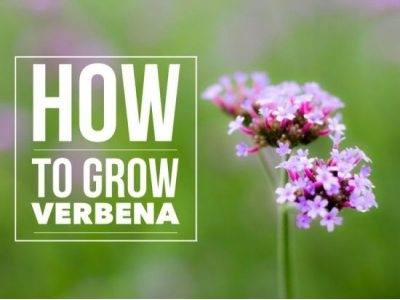How to Grow Verbena

Verbena is a must-have plant for every garden because of its tendency to bloom from spring to fall with very little maintenance. Although verbena is considered to be perennial in warm climates where frost is never a danger, it has to be grown as an annual in climates that have freezing temperatures.
Verbena plants grow in clumps six to 10 inches tall, making it ideal as a hanging basket plant. The colorful blooms can be red, white, pink, mauve, purple or apricot and provide pretty accents for rock gardens, window boxes or borders.
PLANTING VERBENA
Verbena can be started from seeds, but it does take them a long time to germinate. Start indoors in late winter by placing two seeds in peat or fiber pots. Cover very lightly with soil. Water taking care not to make the soil too wet and be prepared to wait about a month for the seeds to show any signs of life. Once the plants have three or four leaves, they can be hardened for outdoor use.
Verbena is a common plant that grows well in U.S. Department of Agriculture hardiness zones two through eight, so most garden centers will carry plants. Plant verbena in full sun in areas of the garden or yard that have good drainage. The plants, which should be spaced 10 to 12 inches apart, require eight to 10 hours of sunlight a day and they do not like soil that is on the dry side.
You can also take cuttings of verbena to start additional plants. Some folks dig up verbena plants in the fall and keep them indoors for the purpose of establishing growth for cuttings.
CARING FOR VERBENA PLANTS
Verbena plants do not require a lot of attention. Once established, water the plants only when they dry out. Fertilize once in the spring of the year after they have been planted and established outdoors. Deadhead the faded blooms so that blooming continues long into the gardening season.
If you live in an area where verbena grows as a perennial, cut the plant back in the fall. If verbena is an annual in your area, remove the plants after they finish flowering in the fall.
VERBENA PESTS AND DISEASES
There are not many pests that impact the growth of verbena, but aphids, spider mites, thrips, slugs and snails can take their toll. A spray of soap diluted with water can be effective in the battle of the bugs. Slugs can be defeated by setting an aluminum pie plate filled with beer (use a cheap variety) out in heavily infested areas of your yard or garden. The slugs will be attracted to the beer and will die after taking their fill of the intoxicating beverage.
Diseases such as powdery mildew and leaf spot can affect the plants. There are natural and chemical products available to help control these problems. Ask for advice at your favorite garden center.
Related news
 Sweet William: Growing from Seed
Sweet William: Growing from Seed The Sweet William flower (Dianthus barbatus), hardy in USDA plant hardiness zones 3 through 9, is charming tucked in containers, mixed with other perennials
 Tomato Growing Problems From Improper Watering
Tomato Growing Problems From Improper Watering Probably the single most common mistake made by gardeners growing tomatoes involves watering them. Sometimes it’s too much, other times it’s not enough
 Troubleshooting Tomato Problems
Troubleshooting Tomato Problems There is no better feeling in the world than walking into your own garden and picking a big, red, juicy tomato off of the vine. Slicing into the gorgeous fruit